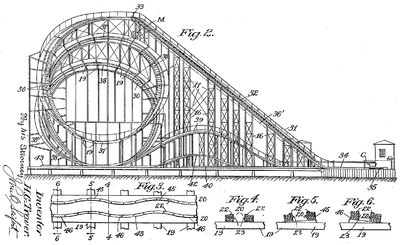Giant Cyclone Safety Coasters
Giant Cyclone Safety Coasters were a model line of roller coasters which were designed and marketed by Harry Traver and his company Traver Engineering in the 1920s. Despite their name, they had a dangerous reputation and are regarded by many historians as some of the most fearsome roller coasters ever built.[1]
Characteristics and design

Robert Cartmell described Traver's coasters as embodying "the reckless spirit of the 1920s".[2] They were built with fully steel frames which had laminated wood and steel tracks. Wood was laminated between 6 and 9 boards thick, depending on the coaster. The steel frames were fabricated in Pittsburgh, Pennsylvania and then shipped by rail to their building sites. The building sites were typically on level ground, and in many cases were by beaches or piers.[3] The main exception, The Palisades Cyclone, suffered increased maintenance problems as a result.[4][5] The laminated wood also had problems with moisture at many locations.[6]
The geometry of Giant Cyclone Safety Coasters was extreme compared to other roller coasters of the time period. The coasters featured very tight turns, spirals, and figure eights.[3] These elements drew inspiration from the swoops and spirals of earlier Prior and Church roller coasters like The Bobs. Curves on Giant Cyclone Safety Coasters were often banked to much steeper angles, with some approaching 85 degrees.[7] Beyond the many curves, another element common to the steel-framed Traver coasters were undulating "jazz tracks", meaning that Traver's Cyclones had almost no straight track in their entire course.[3]
Marketing
The benefits of a steel-framed structure was one of the biggest selling points which was put forward by the Traver Engineering Company. Quicker (and therefore less costly) set-up times were one promoted aspect of the all-steel frames. A resistance to fire and rot were other advantages over wood that were advertised for Giant Cyclone Safety Coasters. Despite the advertisement of low maintenance costs, however, these coasters were actually quite demanding on a maintenance crew.[3] What little wood there was experienced moisture problems,[6] and the coasters were not wholly invulnerable to fire either. The Palisades Park Cyclone, for example, was damaged when the wooden track on the coaster partially burned.[3][5]
Examples and related coasters
Predecessors and prototypes
The model line of Jazz Railways (built at Rocky Glen Park and other locations) was marketed by Traver as the first roller coaster to utilize a completely steel frame. Its stretches of rapidly undulating track were also an innovative feature that saw use in the later Traver Cyclones.[3]
The next step towards the Giant Cyclone Safety Coasters was the Sesquicentennial Cyclone at the Sesquicentennial Exposition in Philadelphia[3] (and several other later locations[8]). The installations of this coaster used the steel frame design introduced with the Jazz Railway, but began to add in the extreme elements which were characteristic of the "Terrifying Triplets" and the Giant Cyclone Safety Coasters more generally. The main difference was the scale. The Sesquicentennial Cyclone was larger than the Jazz Railways, but smaller than the "Terrifying Triplets".[3]
The Terrifying Triplets
The Terrifying Triplets was a nickname given to three roller coasters which were opened or built by Traver in 1927.[1] The Crystal Beach Cyclone was the first coaster to open, followed by the Revere Beach Lightning and then the Palisades Cyclone.[3] Each coaster had the characteristic steel-frame structure with wood-laminated steel track which was typical of Traver-designed coasters. The rides were comparatively short in duration but notorious for their lack of straight track. Their trains had five 4-seat cars, which differed from the ten 2-seat cars of the Sesquicentennial Cyclone.[3]. These heavier cars are also thought to have exacerbated maintenance problems on the Terrifying Triplets.[6]
Other Giant Cyclones
The least well known Giant Cyclone Safety Coaster was the Zip at Oaks Amusement Park in Portland, Oregon.[3] The Zip was a compact version of the "Terrifying Triplets".[2] The coaster opened the same year (1927) as Traver's other Cyclones, but the track length was shortened because of space concerns at the park; it also used shorter trains.[3]
References
- Sandy, Adam (2006). "Harry G. Traver". Ultimate Rollercoaster. Roller Coaster History: Ride Designers. Ultimate Rollercoaster LLC. Retrieved June 6, 2017.
- Cartmell, Robert (1987). The Incredible Scream Machine: A History of the Roller Coaster. Fairview Park, OH and Bowling Green, OH: Amusement Park Books, Inc. and Bowling Green State University Popular Press. ISBN 0879723416.
- Munch, Richard (1982). Harry G. Traver: Legends of Terror. Mentor, OH: Amusement Park Books, Inc. ISBN 0935408029.
- Samuelson, Dale; Yegoiantis, Wendy (2001). The American Amusement Park. MBI Publishing Company. ISBN 0760309817.
- Gargiulo, Vince (2006). Palisades Amusement Park: A century of fond memories. New Brunswick, NJ: Rutgers University Press. ISBN 0813522242.
- Heflin, Joe (Fall 1983). "Traver Cyclones: Re-examination". Coaster World. Vol. 4 no. 3. pp. 8–13.
- Urbanowicz, Steven J. (2002). The Roller Coaster Lover's Companion: A Thrill Seeker's Guide to the World's Best Coasters. New York: Citadel Press. ISBN 0806523093.
- Marden, Duane. "Cyclone (Sesquicentennial Exposition)". Roller Coaster DataBase. Retrieved June 8, 2017.